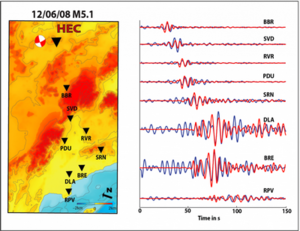Earthquakes“Virtual earthquakes” used to forecast Los Angeles quake risk
Stanford scientists have developed a new “virtual earthquake” technique and used it to confirm a prediction that Los Angeles would experience stronger-than-expected ground motion if a major quake occurred along the southern San Andreas Fault. The new technique capitalizes on the fact that earthquakes are not the only sources of seismic waves – rather, there is also an ambient seismic field consisting of much weaker seismic waves. The scientists devised a way to make these ambient seismic waves function as proxies for seismic waves generated by real earthquakes. By studying how the ambient waves moved underground, the researchers were able to predict the actions of much stronger waves from powerful earthquakes.

"Virtual earthquakes" proving valuable in quake prediction // Source: stanford.edu
Stanford University scientists are using weak vibrations generated by the Earth’s oceans to produce “virtual earthquakes” that can be used to predict the ground movement and shaking hazard to buildings from real quakes.
A Stanford University release reports that the new technique, detailed in the 24 January issue of the journal Science, was used to confirm a prediction that Los Angeles will experience stronger-than-expected ground movement if a major quake occurs south of the city.
“We used our virtual earthquake approach to reconstruct large earthquakes on the southern San Andreas Fault and studied the responses of the urban environment of Los Angeles to such earthquakes,” said lead author Marine Denolle, who recently received her Ph.D. in geophysics from Stanford and is now at the Scripps Institution of Oceanography in San Diego.
The new technique capitalizes on the fact that earthquakes are not the only sources of seismic waves.
“If you put a seismometer in the ground and there’s no earthquake, what do you record? It turns out that you record something,” said study leader Greg Beroza, a geophysics professor at Stanford.
What the instruments will pick up is a weak, continuous signal known as the ambient seismic field.
This omnipresent field is generated by ocean waves interacting with the solid Earth. When the waves collide with each other, they generate a pressure pulse that travels through the ocean to the sea floor and into the Earth’s crust. “These waves are billions of times weaker than the seismic waves generated by earthquakes,” Beroza said.
The release notes that scientists have known about the ambient seismic field for about 100 years, but it was largely considered a nuisance because it interferes with their ability to study earthquakes. The tenuous seismic waves that make up this field propagate every which way through the crust. In the past decade, however, seismologists developed signal-processing techniques that allow them to isolate certain waves; in particular, those traveling through one seismometer and then another one downstream.
Denolle built upon these techniques and devised a way to make these ambient seismic waves function as proxies for seismic waves generated by real earthquakes. By studying how the ambient waves moved underground, the researchers were able to predict the actions of much stronger waves from powerful earthquakes.
She began by installing several seismometers along the San Andreas Fault to specifically measure ambient seismic waves.
